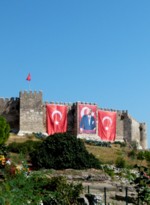The House of the Virgin Mary
The 'Cult of Mary' gained new predominance in the 16th century due to a post-Lutheran need to distinguish Catholics from Protestants. This sectarian rift was soon deepened with the adoption of the 'Rosary' for Marian Prayers (anathema to Protestants as contrary to scripture) and then by 'Marian Apparitions'.
Mary had appeared to some of the faithful since the early days of the Church, yet not a lot had been made of these 'apparitions'. But in in 1531, ten years after the excommunication of Martin Luther, Our Lady of Guadalupe appeared to a converted Indian (indigenous person) in Mexico and, after an initial doubt, the miracle was confirmed by the local Bishop.
The miraculously created Our Lady of Guadalupe icon
in the Basilica of Our Lady of Guadalupe in Mexico City (my photos from 2012)
Mary appeared again in 1608, this time holding the baby Jesus, at Šiluva in Lithuania, on the site of buried documents that showed that land, now claimed by Calvinists, rightfully belonged to Catholics.
Soon the Roman Inquisition endorsed several other apparitions, some historic. While Protestants looked on incredulous more apparitions followed. Now over thirty Marian Apparitions, many quite recent like Lourdes (1858/1862) and Fátima (1917/1930) have been verified by the Inquisition to further fortify the faithful. They mostly occur in Catholic and, to a lesser extent, Coptic communities around the world and have been increasing in frequency - many of them last century.
Notwithstanding Mary's affiliations with Ephesus, unsurprisingly, none of these sightings had been in Muslim Turkey.
This would soon be remotely rectified. Around 1819 the visionary and stigmatist Saint Anna Katharina Emmerick wrote, as a result of a vision in her cell in Germany, that Mary had lived out her mortal life with St John at Ephesus in a forest house in a remote mountainous spot, near a holy spring.
From her description the spot was found in 1881. It was 7 km out of Selçuk in the forest up a steep, winding, mountainous track.
The House of the Virgin Mary
While several of the Saint's visions, that include unicorns that survived the Flood in the Himalayas, are dismissed, this holy site has been given credibility by several Papal visits, including those of Paul VI in 1967 (see above); John Paul II and Benedict XVII (Ratzy).
When we likewise graced the small chapel, that now stands on the site, there was a plastic wizard (from Harry Potter?) standing on the altar. I was offended - one can't go around mixing religious icons like that! I said as much to the woman guarding the chapel against illicit photography. She refused to remove it. So I found a young priest outside and explained the outrage. He rushed to fix it and subsequently came up to me full of thanks, having removed the offending icon. My good deed for the day!
But I did wonder aloud, when descending the precipitous winding road, how the elderly John and Mary fed themselves in such a remote and rocky place - perhaps John was a hunter? At least Snow White had the dwarves to go to the market for flour; and an occasional visit from an old woman carrying fruit.

